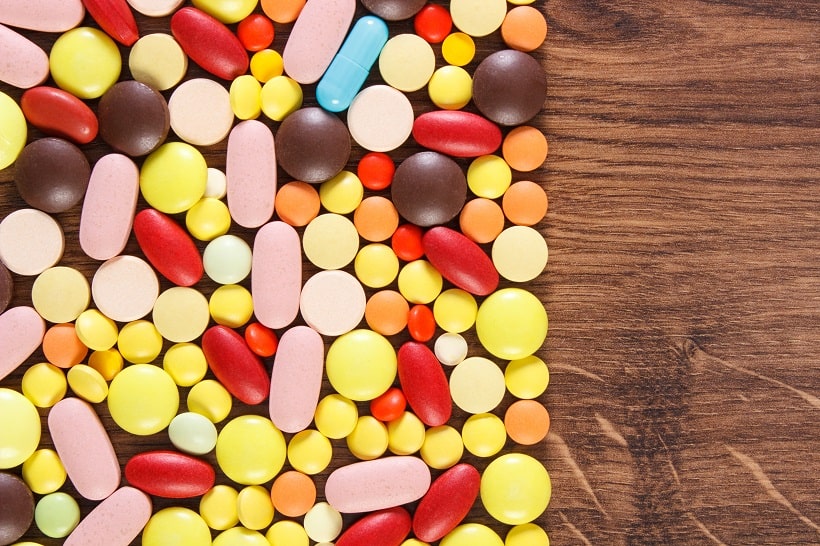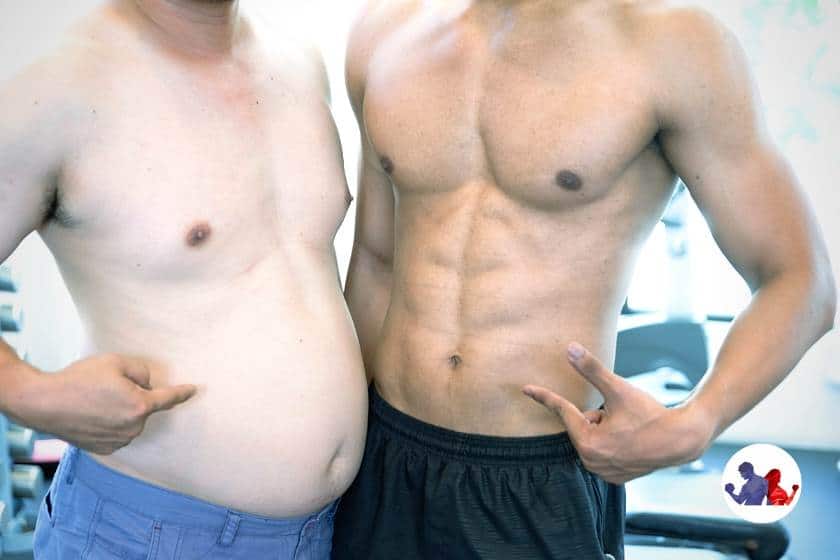The results of scientific research are very clear. Having a high body fat percentage is detrimental to our health and can lead to the development of disease (1).
Whether it be for health or aesthetic reasons, many of us aspire to reduce belly fat. However, so often it feels like an unwinnable battle.
In this article, we will outline nine simple fat loss tips that can help tip the balance in our quest for success.
Table of Contents
What Is Visceral Fat?
When it comes to fat storage, there are particular locations on the body where fat is stored most heavily.
When we overconsume calories, one of the main places for fat to be stored in the belly. This type of fat is known as visceral fat.
One explanation for this is that visceral fat protects and insulates the internal organs located in the abdomen.
Although the body’s propensity is to store fat in the belly, visceral fat does tend to be receptive to lifestyle changes.
By applying a number of the steps below, it is possible to significantly reduce visceral fat.
The Importance Of A Calorie Deficit
Before getting to the steps, let’s briefly consider the mechanism behind fat reduction.
While many like to complicate fat loss, in theory, it is actually very simple. For fat to be broken down, we must establish something known as a calorie deficit.
A calorie deficit is where we consume less calories per day than our body requires. This forces the body to find energy from a source other than food.
Therefore, the body will begin to break down stored body fat for energy. Providing this deficit is maintained over a prolonged time, significant fat loss will occur.
9 Simple Steps To Get Rid of Belly Fat
There are a number of lifestyle changes that can be made to contribute towards the creation of a calorie deficit.
The majority of the following steps revolve around nutrition and exercise as these have the biggest impact on calories.
1. Start Tracking Calorie Intake
As highlighted, creating a calorie deficit is of utmost importance for causing fat reduction. The simplest way to do this is to reduce the amount of calories you eat per day.
By consistently consuming fewer calories, a deficit will be established and fat will reduce.
One of the best ways to ensure that you are consuming the right number of calories is to track.
While it is possible to lose weight without tracking, it is possible for individuals to underestimate their calorie consumption.
As a result, they will not establish a calorie deficit and will not experience fat loss.
Ultimately, by not tracking we are playing a guessing game. On the other hand, studies on tracking and adherence advocate the use of tracking for body compositional changes.
One particular study split participants into two groups. The first group tracked their food intake and exercise while the second group did not.
The study concluded that the tracking group achieved greater weight loss results in comparison to the non-tracking group (2).
![]()
2. Consume More Fiber
Fiber is an indigestible material that can be found in cereals, fruits, vegetables, nuts, and seeds.
There are two different types of fiber – soluble and insoluble. Soluble fiber dissolves in water while insoluble fiber does not.
Both soluble and insoluble fiber play a vastly important role in digestion. However, consuming a healthy amount of fiber can also indirectly impact fat loss.
Studies on the substance have determined that it can suppress hunger and regulate our appetite.
When consumed, fiber appears to slow the digestive process thus enhancing feelings of fullness and reducing appetite.
This is particularly valuable for those on a calorie-restricted diet when often hunger becomes problematic.
Research suggests that increasing fiber intake can cause individuals to consume fewer calories.
One study investigated the impact of consuming an additional fourteen grams of fiber per day. Participants consumed 10% fewer calories and, on average, lost four pounds of weight (3).
Furthermore, another study found that increasing fiber consumption led to a 3.7% reduction in visceral fat (4).
3. Increase Protein Intake
Protein is a macronutrient that is primarily required for growth and development within the body.
However, increasing protein intake may also be beneficial for bringing about fat loss.
In a similar fashion to fiber, protein has been found to control appetite and decrease feelings of hunger. It does this by regulating two hunger hormones known as ghrelin and leptin.
Furthermore, increasing protein intake has been linked with increasing the body’s metabolism. This is simply the number of calories the body naturally burns per day.
By eating more protein and consequent metabolism, a greater number of calories may be burned thus facilitating fat loss (5).
Interestingly, one specific study assessed the relationship between protein consumption and visceral fat.
The study concluded that participants who consumed quality sources of protein were more likely to have less visceral fat (6).
One final benefit of consuming more protein is in regards to muscle mass.
Although a calorie deficit causes a reduction of fat, it may also cause muscle tissue to break down.
Research indicates that following a high-protein diet helps to preserve muscle mass while in a calorie deficit (7).
4. Reduce Carbohydrate Consumption
Another commonly used method to cause fat loss is to restrict carbohydrates.
Although many attribute the cutting of carbs to cause fat loss, it is really to do with calories, once again.
Carbohydrates tend to be macronutrient that we consume most of. The majority of our meals and snacks will have a carbohydrate component.
Therefore, by reducing the number of carbs consumed, we also drastically reduce calorie intake. And as we know, reducing calorie intake can lead to significant fat loss.
This approach may also positively impact appetite and restrict calorie intake further (8).
Studies on low-carb diets have consistently shown this approach to be effective.
Two studies placed participants on a low-carb diet to assess its effects. After eight weeks the results were collected.
Participants in both studies significantly improved their body composition and also reduced abdominal fat (9).
5. Consider Using Supplements

Over the past decade, supplements have exponentially grown in popularity. For fat loss, there are a number of supplements that may be used to help us achieve our goal.
As highlighted earlier, increasing protein intake can be a useful approach for enhancing fat loss. Therefore, taking a protein supplement may be beneficial.
Fat burners may also be a worthwhile investment. These supplements contain an array of fat-burning ingredients such as caffeine, yohimbine, and glucomannan.
Many of these ingredients increase thermogenesis, which is simply the production of heat. Increasing thermogenesis causes a greater number of calories to be used up.
One study on thermogenic fat burners indicated that the supplement effectively increased energy expenditure (10).
For more on fat burners, check out this article:
- Related – What Is A Fat Burner? Does It Work?
While these products may have a positive impact on our health, they should not be over-relied on.
Ultimately, these products serve to supplement our diet rather than form the main thrust of it.
Best Fat Burner Supplements
Our team have picked up the best fat burner supplements currently on the market to support your goals.6. Drink More Water
Something as simple as increasing the amount of water that we drink can have a big impact on fat loss.
Based on research studies, it appears that increasing water consumption has two substantial effects on the body.
Firstly, consuming plenty of water can enhance satiety levels and help us consume fewer calories.
This is highlighted in a recent study that asked participants to drink water prior to eating a meal. Participants were found to consume significantly fewer calories as a result (11).
Secondly, it appears that consuming water can increase heat production and burn a greater number of calories.
A study assessing water-induced thermogenesis determined that 400 kilojoules could be burned by consuming two liters of water per day (12).
A combination of increased satiety and thermogenesis may have a direct effect on energy availability and fat loss.
7. Increase Activity Levels

Thus far, we have considered nutritional approaches for accelerating fat loss. However, exercise can also have a significant impact on fat loss.
Physical activity burns up calories; therefore, a simple fat loss method is to increase activity levels. Doing so will cause more calories to be expended and a deficit to be established.
Often when talking about activity levels, most people will think about attending the gym.
While attending the gym more regularly is one way of increasing activity levels, this step does not exclusively apply to gym attendance.
Day to day activities require energy – these are often referred to as NEAT (or Non-Exercise Activity Thermogenesis).
Simple activities like walking to work, climbing stairs, fidgeting, and completing errands and chores, can all be considered NEAT.
Increasing NEAT can have a larger impact on energy expenditure and fat loss than most of us realize (13).
Therefore, increasing NEAT, as well as intentional exercise, may increase energy expenditure and place us in a calorie deficit.
8. Strength Train And Perform Cardio
When it comes to exercise, both strength training and cardiovascular activity are important for losing belly fat.
As mentioned previously, a calorie deficit can cause muscle tissue to break down. The primary purpose of resistance training during fat loss is to maintain muscle mass.
In addition to preventing muscle breakdown, strength training causes a modest calorie burn that can contribute to a calorie deficit.
While strength training is of great value, it’s important to understand that “spot reduction” does not work.
This is the belief that performing specific exercises will reduce fat in a certain area of the body.
A study asked participants to perform six-weeks of ab training. The results confirmed that ab training did not have an impact on the amount of visceral fat (14).
Cardiovascular activities, such as running, walking, rowing, and cycling, are associated with high-calorie burns.
Therefore, increasing cardio frequency or intensity may be worthwhile as it will burn a greater number of calories.
Research conducted on the effects or cardio concluded that moderate to high intensities is most optimal for reducing visceral fat (15).
9. Get Plenty Of Sleep
While scientists are still trying to fully understand the mystery that is sleep, it is evident that sleep is essential.
Not only is it essential for maintaining good bodily function, it also appears to influence body composition.
There are many studies that demonstrate the impact that poor sleep has on the body. One such study determined that inadequate sleep increases obesity risk in adults and children (16).
It is thought that insufficient sleep impacts our metabolism and reduces the number of calories burned per day.
In addition, it has been documented that poor sleep also influences the hunger hormones ghrelin and leptin.
Therefore, those who are sleep deprived are more likely to feel hungry, make poorer nutritional choices, and overconsume calories (17).
While sleep need varies from individual to individual, the general recommendation is to get seven to nine hours per night.
- Related – Sleep and Weight Loss: Is There A Link?
FAQs
What causes belly fat?
A calorie surplus (consuming too many calories) leads to an increase in total body fat percentage – this includes belly fat.
Overconsumption of calories provides the body with an energy surplus. Consequently, the body stores this energy as body fat to be used as an energy reserve.
What is the fastest way to lose belly fat?
Unfortunately, effective fat reduction is often a slow and steady process. However, this is how we want it to be.
Often rapid fat loss is unsustainable and, inevitably, fat stores will increase once again.
The most optimal fat loss method is to maintain a moderate calorie deficit over a prolonged time.
What exercises burn the most belly fat?
It’s important to recognize that we cannot spot reduce fat in specific places.
With a calorie deficit, body fat percentage will reduce throughout the body.
That said, there are high-calorie burning exercises that can facilitate a calorie deficit and fat loss.
Cardio and full-body exercises are typically best for burning a large number of calories.
Can supplements help me lose belly fat?
Specific supplements, such as protein shakes and specific fat burners, may enhance our metabolism and lead to a greater calorie burn.
That said, while supplements can certainly be useful, it’s important that they are not over-relied on.
How quickly should I be losing fat?
With a modest calorie deficit, it is estimated that one to two pounds of body weight will be lost per week.
That being said, there are a number of individual factors that can determine the rate of weight loss.
Therefore, keep in mind that this is nothing more than an estimation.
Summary

Eating too many calories causes an increase in stored body fat and much of it is stored within the abdomen.
To successfully reduce belly fat, it is imperative that a calorie deficit is established and maintained. This is simply where fewer calories are consumed per day than the body burns.
The main two ways of creating this deficit are to consume fewer and burn more. This explains why the majority of the steps revolve around diet and exercise.
By applying a number of the aforementioned science-based steps, it is possible to significantly reduce belly fat.
- https://www.ncbi.nlm.nih.gov/pmc/articles/PMC5935926/
- https://pubmed.ncbi.nlm.nih.gov/23229890/
- https://pubmed.ncbi.nlm.nih.gov/11396693/
- https://www.ncbi.nlm.nih.gov/pmc/articles/PMC3856431/
- https://pubmed.ncbi.nlm.nih.gov/17495198/
- https://pubmed.ncbi.nlm.nih.gov/22284338/
- https://pubmed.ncbi.nlm.nih.gov/19927027/
- https://pubmed.ncbi.nlm.nih.gov/17228046/
- https://www.ncbi.nlm.nih.gov/pmc/articles/PMC4264021/
- https://www.ncbi.nlm.nih.gov/pmc/articles/PMC4818444/
- https://www.ncbi.nlm.nih.gov/pmc/articles/PMC6209729/
- https://pubmed.ncbi.nlm.nih.gov/14671205/
- https://www.ncbi.nlm.nih.gov/books/NBK279077/
- https://pubmed.ncbi.nlm.nih.gov/21804427/
- https://www.ncbi.nlm.nih.gov/pmc/articles/PMC3568069/
- https://www.ncbi.nlm.nih.gov/pmc/articles/PMC2398753/
- https://pubmed.ncbi.nlm.nih.gov/15583226/
